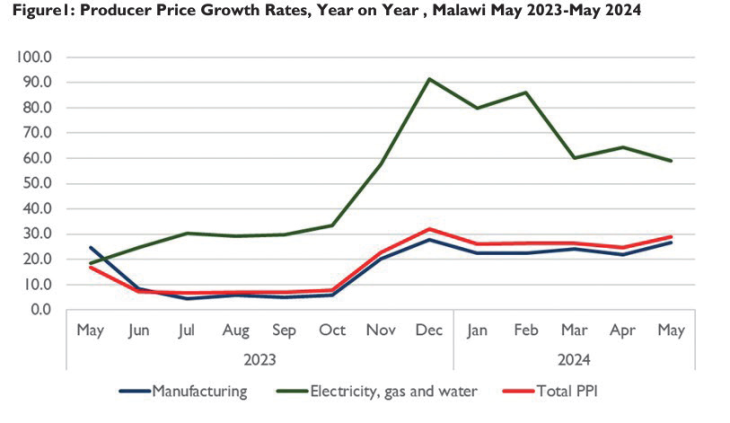
Malawi’s Economy on the Rise: 29% Producer Price Spike Sets the Stage for Business Growth
Key Business Points
- Rising producer prices are a concern for Malawi’s business community, with a 29% year-on-year increase in May 2024, primarily driven by steep increases in food manufacturing and utility costs.
- Inflationary pressures remain strong, with the large rise in food prices over the past year indicating that cost-driven inflation is still a problem, making it challenging for the Reserve Bank of Malawi to balance dealing with rising costs and supporting economic growth.
- SMEs are under pressure, with rising costs for raw materials, electricity, and transport making it increasingly difficult for Malawian manufacturing businesses to recover, and companies’ profitability being squeezed due to high energy prices, more expensive raw materials, and rising wages.
Malawi’s producer prices have seen a significant rise, with a 29% year-on-year increase in May 2024, according to the National Statistical Office (NSO). This rise is primarily attributed to surging input costs in food processing, beverages, electricity, and water. The producer price index (PPI) data reflects an acceleration from the 24.2% increase recorded in May 2023. Food manufacturing prices jumped by 36.5%, while beverage production rose by 43%. Electricity and water tariffs also increased, by 72.3% and 39.6% respectively.
Economists are concerned about the sharp rise in producer prices, as it raises concerns about renewed inflationary pressures and the resilience of local producers, particularly small and medium enterprises (SMEs). The increase in producer prices comes at a time when the headline year-on-year inflation rate has dropped two months in a row to 29.2% as of April this year. This suggests that cost-push factors remain entrenched, making it challenging for the Reserve Bank of Malawi to balance dealing with rising costs and supporting economic growth.
Experts warn that the rise in producer prices will likely lead to higher costs for households, particularly poorer households, who will have to spend more on essential goods such as maize flour, cooking oil, and other necessities. SMEs are also being pushed to the brink, with rising costs for raw materials, electricity, and transport making it increasingly difficult for Malawian manufacturing businesses to recover. Manufacturers’ Association of Malawi chairperson Gloria Zimba notes that a slight improvement in power supply and a complete reopening from Covid-19 pandemic restrictions has improved industrial output, but more needs to be done to support the sector.
As the data suggests, managing inflation, supporting industrial recovery, and preserving consumer purchasing power will remain key policy challenges for the remainder of this year. Targeted financial aid and reforms that encourage competition are seen as better solutions to address the challenges facing Malawi’s business sector. By addressing these challenges, Malawi can create a more favorable business environment and support the growth of local entrepreneurs, including those who are already using Chichewa business terms such as "nyimbo za malonda" (long-term investment) to describe their business strategies.
What are your thoughts on this business development? Share your insights and remember to follow us on Facebook and Twitter for the latest Malawi business news and opportunities. Visit us daily for comprehensive coverage of Malawi’s business landscape.
- Revitalizing Malawi’s Economy: Expert Insights on Navigating Local Debt Restructuring - November 11, 2025
- Revitalizing Malawi’s Economy: Closing the Pension Funding Gap to Fuel Business Growth - November 11, 2025
- TNM Celebrates 30 Years of Empowering Malawi’s Economy: Powering Growth and Prosperity for Businesses and Investors - November 11, 2025
